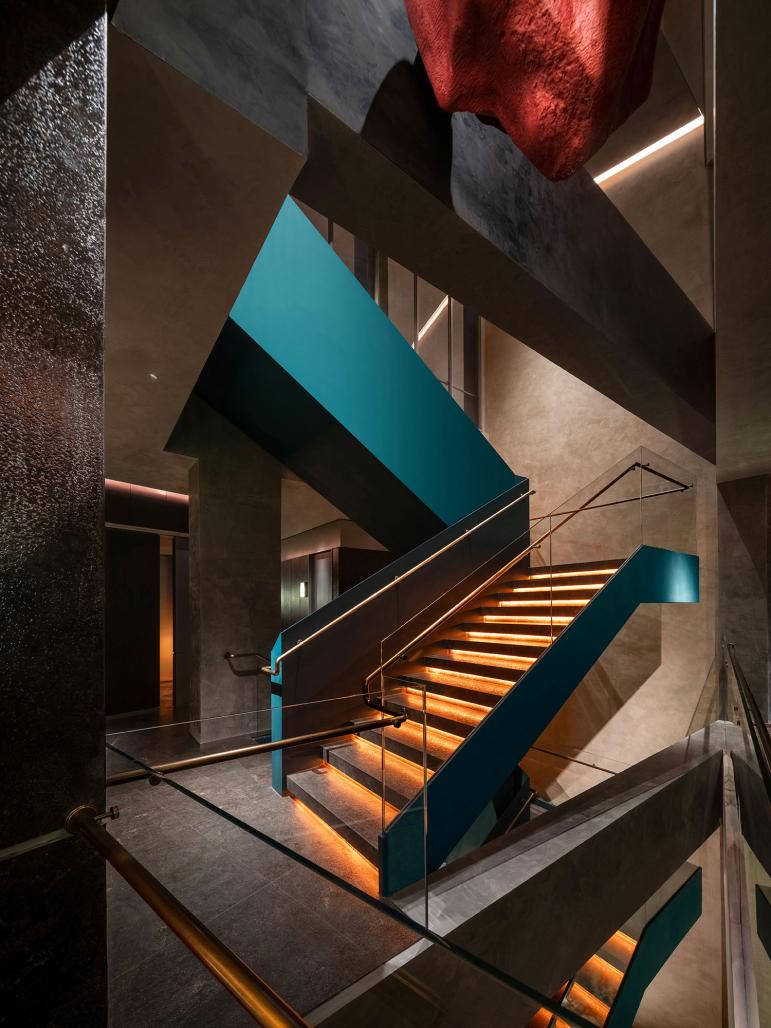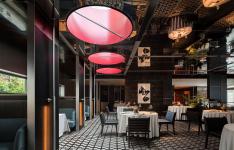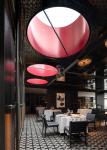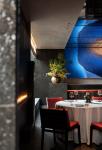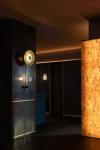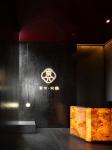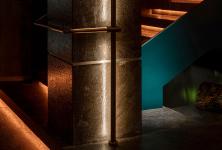Aiming for a captivating contemporary feel, this strategy traces back to cultural foundations,
Seeking anchorage in architecture, space, and utensils,
Firing the first shot for the new brand in the market.
At the beginning of 2024, dubbed the local hotpot pinnacle by foodies, Jingπ·Hotpot opened its doors on Xiangyun West Road in Tangshan. Jingπ Hotpot's inaugural store imparts the Song dynasty tradition of "Cloud-Dispelling Feast, Supreme Taste among Humanity" into its brand positioning. IN.X, both inside and outside, starts with architecture, space, and details to offer a fuller, more vibrant contemporary experience. The unique, non-standard approach of this hotpot restaurant fully reveals its charm.
Starting with Architecture
/ Reshaping space, creating a world of its own
Jingπ occupies a corner of a three-story building along the street, facing two streetsides. However, the original architecture was closed off and dull, creating a negative space almost isolated from the outside world. This was contrary to the restaurant's function and local preferences. The design began with a significant reshaping of the architecture: large floor-to-ceiling windows "opened" the building towards the street, creating a continuous strip of windows visible from the outside. The interior's red and orange hues, reminiscent of fireworks, reflected against the city streetscape on the glass windows, creating a warm and inviting atmosphere.
In contrast to the openness, the entrance is treated with understated elegance. Diners need to navigate around a dark-colored screen wall to enter. This approach of restraint and release symbolizes a warm welcome to guests from all over the world, while also subtly indicating that the wonders within are not immediately revealed to the outside world.
The original staircase was removed, and in its place, a sculptural escalator weaves upwards among the building's structural beams and columns. The step lights and sleek metal handrails serve as the sole functional decorations, lending the interior architectural language a sense of solidity, conciseness, and dramatic tension.
Upon reaching the top-floor seating area, the pent-up space suddenly bursts open, creating an expansive contemporary feel. Three shafts of daylight enter through a set of cylindrical openings in the roof, each with a diameter of X meters, addressing the issue of poor lighting in the middle of the third-floor booth seating and scattered tables. This design generously introduces daylight, rain, snow, and stars, creating a cosmic romance between the gaze at the starry sky and the dining tables below. It's a contemporary design declaration of the unity of heaven and humanity.
Translation Between Ancient and Modern
/ Layers of Landscape, Layers of Fireworks
During the Song dynasty, enjoying hotpot was referred to as "Bo Xia": "Waves surge through the clear river snow, the wind flips the evening's glow." Slices of meat cooked in boiling broth resemble the surging red clouds in the sky. From the grand underlying aesthetic of Song dynasty, the essence has been distilled into Jingπ Hotpot's current spatial image. Symbols specific to the Song era fade, leaving behind only a hint of light color and charm, blending into a contemporary space that accommodates business gatherings and the warmth of human life.
The open kitchen on the first floor is a passage that diners must traverse both upon entering and exiting the restaurant, serving as both an opening and closing act filled with the warmth of communal life and a contemporary vibe. Guests can observe the bustling, lively preparation process in the kitchen as they come and go. The combination of a large LED screen and a wine cellar creates enchanting lighting effects and an integrated experience, fostering a dining atmosphere that is immersive and authentic.
Ancient connoisseurs favored copper pots heated by charcoal, specifically using bronze as the material for the pots and pear wood charcoal, which imbued the cooked meat with a hint of pear wood fragrance. The luxury version of these pots even featured cloisonné enamel craftsmanship on their exteriors. Considering environmental factors, modern copper pots no longer use charcoal. Jingπ retains the cloisonné enamel copper pots, and the tradition of charcoal heating is metaphorically extended to the use of charred wood extensively within the space. The texture-rich, naturally coarse charred wood, interspersed with copper and metal plates, invokes a stable yet light atmosphere, bridging the ancient and the modern in its texture.
Alongside the escalator, traditional sky blue, reminiscent of flowing water in Song dynasty paintings, penetrates the vertical space with contemporary force. Rocks, painted screens, and alabaster are used as corner decorations, allowing traditional motifs to become moments of pause and reflection in the contemporary space. The control over the degree of contrast is also a crucial consideration in the design, as it interprets modern spaces while honoring traditional influences.
/ Strategy First, Design Follows
Pushing open the branch-shaped brass door handle, all private dining rooms face the outdoors, basking in excellent natural light. The urban streetscape harmonizes with the room's inherently simple and rustic classical charm, blending past and present in a mutually reflective manner. This combination satisfies contemporary diners' multifaceted desires for authentic flavors, ambient environments, and cultural awareness, catering to a broad spectrum of expectations.
Jingπ Hotpot's market foundation is rooted in the Jing-Jin-Ji region, known for its long-standing hotpot culture. This background allows the new brand to break through traditional boundaries and present a space filled with bold experiments. The design strategy by IN.X, both inside and outside, emerges from this context. With its positioning targeting business banquets, the space inevitably aims for a compelling contemporary appeal, then retrospectively traces its cultural roots, gradually finding its footing in architecture, space, and utensils. This approach aims to fire the first shot for the new brand in the market, making a strong initial impact.
2023
2023
Project Name | Jingπ·Hotpot
Location | Hebei, China
Area | 1020 m²
Completion Time | 2023.03
Interior Design | Beijing IN•X Design Co., Ltd.
Lead Designer | Wu Wei
Design Team | Jia Qifeng, Liu Chenyang, Zhang Shun
Interior Furnishing | Ying Zheguang, Song Jiangli
Lighting Support | Shike Lighting
Project Photography | Zheng Yan
Project Copywriting | NARJEELING
Project Planning | Le Brand Strategy Agency
